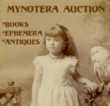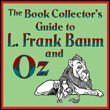|
|
|


|
|

|
Taking Bookselling To The Top
by Craig Stark
#85, 1 January 2007
|
In Part III of this series I explained in some detail how a simple typo - striking an "8"
instead of a "2" when entering an eBay auction reserve price - had miraculously netted me
an additional $6,000 on a rough proof of George Bernard Shaw's Pygmalion. The buyer had no doubt made up his mind not to let the book get away from him, no matter what the price. It was my day in the sun. Also, previous to this sale, I'd sold a Civil War pardon letter signed by President Lincoln for $4,375. With these two items alone I'd made back my initial $5,500 investment and pocketed almost $5,000 in profit. Though I still had a few dozen GBS signed first editions and numerous pieces of GBS ephemera to unload, some of it handwritten letters and postcards, not to mention an album that contained dozens of pasted down Ford Theater playbills and a mysterious, brittle court document from the 1830s, I'd pretty much resigned myself to the fact that the big sales were behind me.
In the ensuing months I sold the best of the Shaw stuff. Several things went for over a thousand, many more for somewhat less. It was all good, however, and it was all gravy. The playbills were a different story. I shelved the album, also the court document and some miscellaneous Lincoln stuff, and essentially put them out of mind. At this point, I'd had no reason to question the assessment of my acquaintance who'd told me that somebody at Christie's had estimated their value (given their pasted-down state) at about $50 each. Worse, even if an enclosed note could be taken as gospel, there were supposedly only two genuine playbills in the album, and the rest were fakes. So, you know, big deal. Given the modest potential payoff, I didn't want to take the time to authenticate them, so there they sat. And sat.
Much later, maybe a year or two later, I completed the construction of a two-room book cottage in the back yard - the house could no longer accommodate my inventory - and the long process of moving everything out there began. During this process, the album inevitably surfaced, and, well, you know how it is when you start going through stuff that you haven't seen recently: It's fresh again, and you bring a fresh pair of eyes to it. I leafed through it again, slowely, paying closer attention this time to the accompanying documentation, some of which consisted of actual auction records with prices paid for several of the playbills. And not insignificant prices at that. Why hadn't that registered before?
I also looked closely at a letter that had been laid into the album. I recalled reading it before - it was a ho-hum thank-you note for a gift of Lincoln memorabilia - and had concluded that it was of little interest. For some reason, however, the signature at the bottom now caught my eye. The first name was virtually illegible - nothing but scrawled, compressed letters - but the last name looked like it could've been ... "Cleveland." The only Clevelands I knew were a company that made golf clubs, which had no relevancy, and (Stephen) Grover Cleveland, none other than the 22nd (and 24th) President of the United States. A Google search instantly netted several images of Cleveland's signature, and indeed all online Grovers bore a striking resemblance to mine.
A handwritten, signed presidential letter seemed somewhat more promising, though I knew that Cleveland wasn't nearly as collectible as Lincoln. Still, I felt that it at least merited making an inquiry, so I emailed Christie's, attaching a photograph of the letter and explaining that it was part of an album of Ford Theater playbills.
The reply came quickly - and the letter wasn't even mentioned. What was mentioned was the album. Apparently, it was something "of interest," and Chris Coover (of Antiques Roadshow fame) asked if he could call me. Well, yes, he could, and during our subsequent conversation, he cited a previous sale of $13,000 for a single, genuine playbill in 1990! The fact that mine were mounted would likely depress values some, but if one or more of them proved to be genuine, well, thousands might be possible.
Thousands? That certainly beat $50 each, and he said would send me some information that would enable me to make a preliminary determination. Apparently there were numerous issue points that needed to be confirmed before the word "genuine" could be attached to anything.
When would I get it?
The next day.
When things are of interest, seemingly, things move fast.
As promised, the next day I received photocopies of two documents, one a ca. 1937 article, "The Ford Theatre Lincoln Assassination Playbills: A Study," by Walter C. Brenner and the other an except from a February 7, 1985 Library of Congress Bulletin titled "Library Catalogs Playbills from Night of Lincoln Assassination." Both explained why there were two different genuine playbills. Here's the LOC version:
"There were two original versions of the playbill printed by Ford's Theatre for the night of April 14, 1865. The printing of the playbills was already in progress in the morning when the news came that the President would view the evening performance. It was decided to mark the occasion by having Laura Keene, the leading lady, sing H.B. Phillips' "Honor to Our Soldiers." The song was to be sung during the intermission between the second and third acts. As it happened, Laura Keene was not ready to appear at the assigned time and never did sing for the President. This having been arranged, Mr. Polkinhorn, the theater printer, halted the production of the playbills in progress and inserted the eight-line stanza of "Honor to Our Soldiers" into the remaining number of programs."
The LOC itself holds only one of these playbills, the second issue, but it's believed to be the holy grail, the one retrieved from Lincoln's own theater box - and it bears a blood stain! In any case, Brenner asserts that, immediately following the assassination, considerable numbers of counterfeit copies of the first issue were produced using the same type used by the printer of the genuine playbills - but, he's careful to point out, not to the printer's knowledge. So closely did the counterfeits resemble the originals, however, that Brenner's study was specifically undertaken to distinguish them.
Here are Brenner's images of the two genuine issues:
|
|







|
|












|


